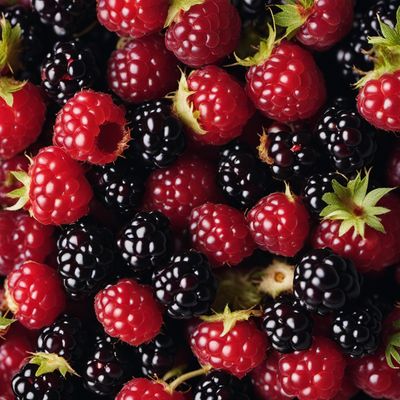
Ingredient
Cane fruits
The Sweet Bounty of Nature: Exploring the World of Cane Fruits
Cane fruits are a collection of berries that grow on thorny canes, including raspberries, blackberries, and boysenberries. These fruits are characterized by their small, round shape, juicy flesh, and a wide range of colors, from deep red to black. They have a delicate yet slightly tart taste, and their texture can vary from soft and tender to slightly firm, depending on the specific variety.
Origins and history
Cane fruits have a rich history that dates back centuries. Raspberries are believed to have originated in Eastern Europe, while blackberries have been enjoyed since ancient times in both Europe and North America. Boysenberries, a cross between raspberries, blackberries, and loganberries, were developed in the early 20th century in California. These fruits have been cherished for their flavor and nutritional value throughout history, and they hold cultural significance in various cuisines around the world.
Nutritional information
Cane fruits are packed with essential nutrients, including dietary fiber, vitamin C, and antioxidants. They are low in calories, with approximately 50-60 calories per cup, making them a guilt-free addition to a balanced diet.
Allergens
Cane fruits are generally not associated with common allergens, but individuals with berry allergies should exercise caution and consult with a healthcare professional if necessary.
How to select
When selecting cane fruits, look for plump, firm berries that are brightly colored and free from mold or bruises. Avoid berries that are overly soft or have a dull appearance. It is also advisable to choose organic or locally grown options when available to ensure the best quality and flavor.
Storage recommendations
To maintain the freshness of cane fruits, store them unwashed in a single layer in the refrigerator. They are highly perishable and should be consumed within a few days. Avoid storing them in airtight containers, as moisture can promote mold growth.
How to produce
Cane fruits can be grown in home gardens or containers, provided they receive ample sunlight and well-drained soil. They are typically propagated through cuttings or purchased as young plants from nurseries. Regular pruning and proper care are essential for optimal growth and fruit production.
Preparation tips
Before using cane fruits, gently rinse them under cold water to remove any dirt or debris. They can be enjoyed fresh as a snack, added to salads, used in desserts, or transformed into jams, jellies, or sauces. To enhance their flavor, sprinkle a touch of sugar or drizzle honey over the berries. Cane fruits also pair well with dairy products, such as yogurt or ice cream.
Substitutions
If cane fruits are not available, suitable substitutes include other berries such as strawberries or blueberries, which offer similar sweetness and texture.
Culinary uses
Cane fruits are incredibly versatile in the culinary world. They can be used in a wide range of dishes, including pies, tarts, cakes, muffins, smoothies, and fruit salads. They also make excellent toppings for pancakes, waffles, and yogurt parfaits. Additionally, cane fruits can be transformed into delightful preserves, syrups, or coulis to enhance the flavor of various desserts and savory dishes.
Availability
Cane fruits are commonly available in regions with temperate climates, including North America, Europe, and parts of Asia. They are also cultivated in countries such as the United States, Mexico, Canada, Poland, and Serbia.


